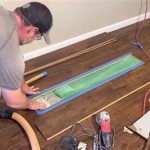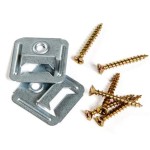How To Remove Super Glue From Vinyl Plank Flooring
Super glue, also known as cyanoacrylate adhesive, is a powerful bonding agent commonly used in households for quick repairs and various craft projects. While its strong adhesive properties are beneficial in many situations, accidental spills onto vinyl plank flooring can present a significant challenge. Vinyl plank flooring, prized for its durability and water resistance, can still be damaged by super glue if removal is not handled with care. This article provides detailed instructions and various methods to effectively remove super glue from vinyl plank flooring without causing permanent damage.
The success of super glue removal depends on several factors, including the amount of glue spilled, the length of time it has been allowed to set, and the specific type of vinyl plank flooring. Some vinyl planks are more sensitive to certain solvents or abrasive cleaning methods than others. It is crucial to assess the situation and select the appropriate removal technique to minimize the risk of scratching, discoloration, or other forms of damage.
Before attempting any removal method, it is recommended to test the chosen technique on an inconspicuous area of the flooring, such as under furniture or inside a closet. This practice ensures that the method does not adversely affect the appearance or integrity of the vinyl plank. If any discoloration or damage occurs during the test, a different removal method should be selected.
Safety precautions are paramount when working with solvents or sharp tools. Always wear appropriate protective gear, including gloves and eye protection, to prevent skin and eye irritation. Ensure adequate ventilation in the work area to avoid inhaling harmful fumes. Keep children and pets away from the area until the cleaning process is complete and the area is thoroughly dried.
Key Point 1: Initial Assessment and Preparation
The first step in removing super glue from vinyl plank flooring is a thorough assessment of the situation. This involves evaluating the size and thickness of the glue spill, the age of the stain, and the type of vinyl plank flooring. This information will guide the selection of the most appropriate removal method. Gather the necessary materials before beginning the removal process. These may include:
- Soft cloths or microfiber towels
- Plastic scraper or putty knife
- Acetone (nail polish remover)
- Isopropyl alcohol (rubbing alcohol)
- Mild dish soap
- Warm water
- Cotton swabs
- Heat gun or hairdryer (optional)
Before attempting any removal method, gently scrape away any loose or hardened pieces of super glue with a plastic scraper or putty knife. Avoid using metal scrapers, as they can easily scratch the vinyl surface. Work carefully, applying gentle pressure to avoid gouging or damaging the flooring. The goal is to remove as much of the hardened glue as possible before applying any solvents. Once the loose pieces are removed, clean the area with a damp cloth to remove any dust or debris.
If the super glue spill is fresh and has not yet hardened, immediately blot the area with a clean, dry cloth. Avoid rubbing the spill, as this can spread the glue and make removal more difficult. Continue blotting the area until no more glue is transferred to the cloth. Then, proceed with one of the removal methods described below.
Key Point 2: Solvent-Based Removal Methods
Several solvents can be used to soften and dissolve super glue, making it easier to remove from vinyl plank flooring. The most common and effective solvents include acetone and isopropyl alcohol.
Acetone (Nail Polish Remover): Acetone is a powerful solvent that can effectively dissolve super glue. However, it is important to use it with caution, as it can also damage some types of vinyl flooring. Before applying acetone to the affected area, test it on an inconspicuous area of the flooring to ensure that it does not cause discoloration or damage. If the test is successful, proceed with the following steps:
- Soak a cotton swab or clean cloth with acetone.
- Gently dab the acetone onto the super glue stain, avoiding contact with the surrounding flooring.
- Allow the acetone to sit on the stain for a few minutes to soften the glue.
- Use a plastic scraper or putty knife to gently lift the softened glue from the flooring.
- Repeat steps 1-4 as necessary until the glue is completely removed.
- Clean the area with a damp cloth to remove any residual acetone.
- Dry the area thoroughly with a clean, dry cloth.
Isopropyl Alcohol (Rubbing Alcohol): Isopropyl alcohol is a milder solvent than acetone and may be less likely to damage vinyl flooring. It can be used in a similar manner to acetone:
- Soak a cotton swab or clean cloth with isopropyl alcohol.
- Gently dab the alcohol onto the super glue stain.
- Allow the alcohol to sit on the stain for several minutes to soften the glue.
- Use a plastic scraper or putty knife to gently lift the softened glue from the flooring.
- Repeat steps 1-4 as necessary until the glue is completely removed.
- Clean the area with a damp cloth to remove any residual alcohol.
- Dry the area thoroughly with a clean, dry cloth.
If the super glue is particularly stubborn, it may be necessary to combine the solvent-based removal method with a gentle heat source. A heat gun or hairdryer can be used to warm the glue, making it easier to soften and remove. However, it is important to use caution when applying heat to vinyl flooring, as excessive heat can cause damage or discoloration. Keep the heat source moving and avoid holding it in one spot for too long. After applying heat, immediately apply acetone or isopropyl alcohol and proceed with the scraping process.
Key Point 3: Alternative Removal Methods
In addition to solvent-based methods, several alternative techniques can be used to remove super glue from vinyl plank flooring. These methods may be less effective than solvents for stubborn stains, but they are generally safer for the flooring and may be suitable for more delicate vinyl planks.
Warm Soapy Water: A solution of warm water and mild dish soap can sometimes be effective in softening super glue. The soapy water helps to loosen the bond between the glue and the flooring, making it easier to scrape away.
- Mix a small amount of mild dish soap with warm water.
- Soak a soft cloth in the soapy water and wring out the excess.
- Place the damp cloth over the super glue stain and allow it to sit for 15-20 minutes.
- Use a plastic scraper or putty knife to gently lift the softened glue from the flooring.
- Repeat steps 1-4 as necessary until the glue is completely removed.
- Clean the area with a damp cloth to remove any residual soap.
- Dry the area thoroughly with a clean, dry cloth.
Cooking Oil or Mineral Oil: Oils can help to penetrate the super glue and weaken its bond with the flooring. Apply a small amount of cooking oil or mineral oil to the glue stain and allow it to sit for several hours or overnight. The oil will gradually soften the glue, making it easier to scrape away. After allowing the oil to sit, gently scrape the softened glue with a plastic scraper and clean the area with a damp cloth to remove any residual oil.
Baking Soda Paste: A paste made from baking soda and water can act as a mild abrasive, helping to gently scrub away the super glue. Mix baking soda with water to form a thick paste. Apply the paste to the super glue stain and gently scrub the area with a soft cloth or toothbrush. Rinse the area with water and dry thoroughly. This method is best suited for small, localized stains.
Ice Pack: Applying an ice pack to the super glue can cause it to become brittle and easier to shatter. Place an ice pack wrapped in a cloth over the glue stain for several minutes. Once the glue is frozen, gently tap it with a plastic scraper to break it into small pieces. Remove the pieces and clean the area with a damp cloth.
After removing the super glue, it is important to thoroughly clean the area with a vinyl floor cleaner to remove any residual solvent or oil. Follow the manufacturer's instructions for the cleaner and ensure that it is safe for use on vinyl plank flooring. Buff the area with a clean, dry cloth to restore the shine and protect the flooring.
In some cases, despite best efforts, some discoloration or damage may remain after removing super glue from vinyl plank flooring. In such cases, consider consulting with a professional flooring contractor for advice on repairing or replacing the affected planks. They may have access to specialized cleaning products or repair techniques that can restore the flooring to its original condition.

How To Remove Glue From Vinyl Floor Ready Diy

How To Clean Floor Glue And Heavy Dirt Off Luxury Vinyl Flooring

How To Remove Glue Or Adhesive From Vinyl Flooring After Installation

How To Remove Glue From Vinyl Floor Ready Diy

How To Remove Glue Or Adhesive From Vinyl Flooring After Installation

How To Remove Glue Or Adhesive From Vinyl Flooring After Installation

How To Remove Glue From Vinyl Floor Ready Diy

Removing Super Glue Residue And Stains

How To Remove Glue From Vinyl Floor Ready Diy

How To Remove Glue Or Adhesive From Vinyl Flooring After Installation
Related Posts








